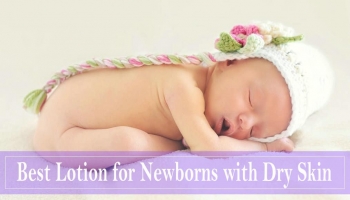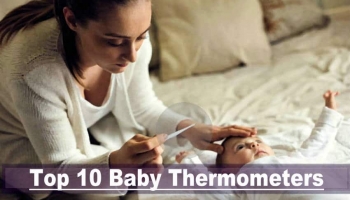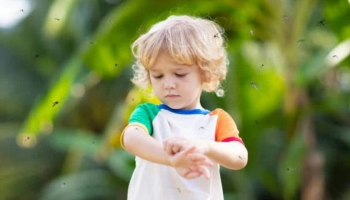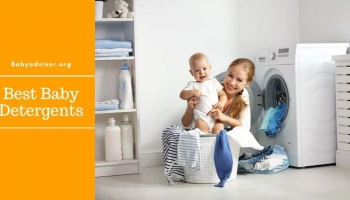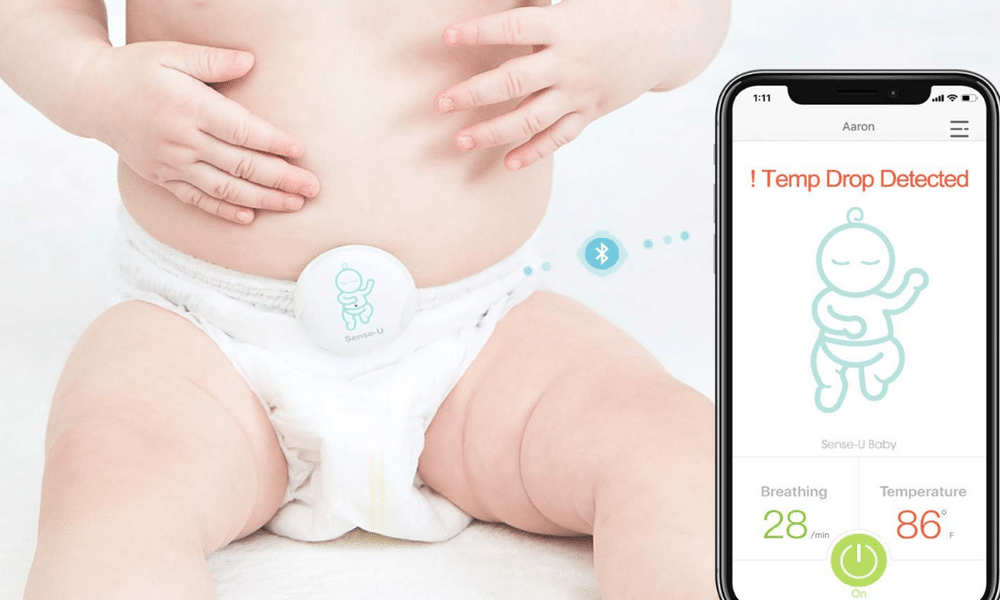
SIDS is a scary reality that all parents have to face upon the birth of their child. When you come home, you might find yourself checking on your baby constantly as he sleeps. Instead of tiptoeing into your baby’s nursery or reaching over into the cosleeper frequently, try one of the best baby breathing monitors to keep your mind at ease.
Baby breathing sparks anxieties for new parents, especially if your baby has respiratory or cardiac problems or was premature. That’s why you need a monitor. These monitors keep track of whether your baby is safe and breathing at an appropriate rate.
That means you can rest more comfortable, and you need all of the rest that you can get.
Quick Recap of the Best Baby Breathing Monitors
- Most Well-Known Breathing Monitor – Owlet Smart Sock Baby Monitor
- Only Monitor with Vibration – Snuza Hero SE
- Best Clip-On Monitor – Sense-U Breathing & Rollover Monitor
- Best for Premature Babies – Babysense 7 – Under the Mattress Baby Movement Monitor
- Best Baby Cam and Breathing Monitor Combo – Cocoon Cam Plus
- Newest on the Market – Nanny Baby Monitor
What’s the Purpose of a Baby Breathing Monitor?
Adults breathe at a steady rate, even while sleeping, but newborns may not do so. Sometimes, babies experience periodic breathing, which is when young babies have pauses in their breathing patterns. Periodic breathing can be normal, especially for preterm babies or during deep sleep, but it can be distressing for you.
If you pay close attention to your baby’s breathing, you will notice that newborns take a few shallow breaths from time to time. Then, there is a pause before they start to breathe again. Using a breathing monitor quickly determines the difference between normal sleep breathing and dangerous breathing patterns.
These monitors watch your baby and let you know any irregularities. It can notice when there are pauses in breathing or a lack of motions that lasts longer than 15 to 20 seconds.
Should Parents Use a Baby Breathing Monitor?
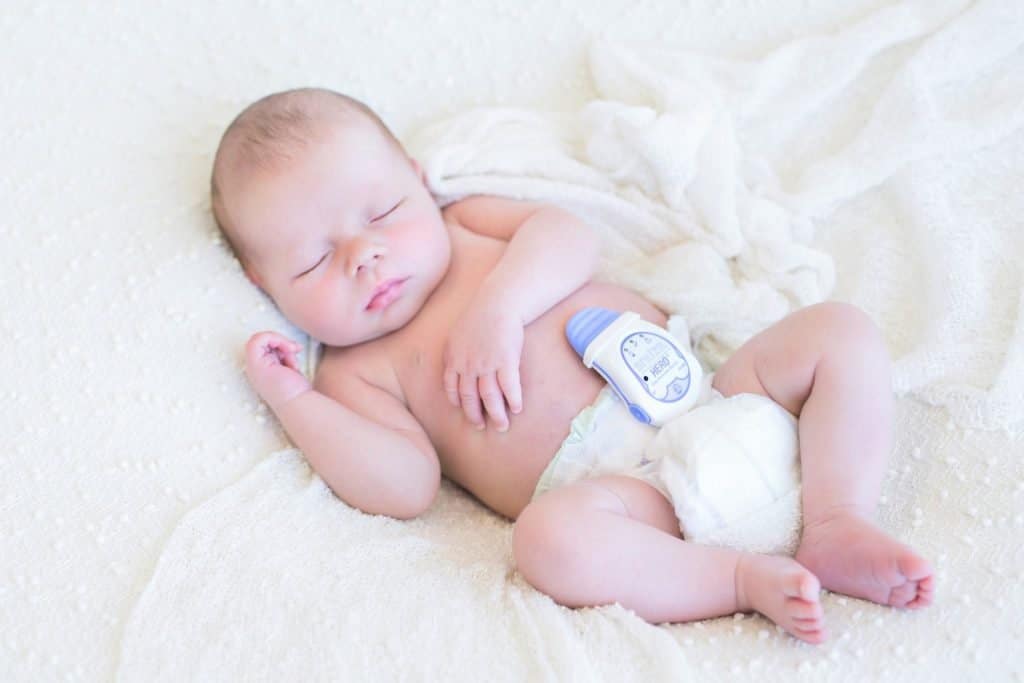
Whether or not you should use a baby breathing monitor is a bit of a debate.
Currently, the American Academy of Pediatrics does not recommend that parents purchase breathing monitors. Research does not support the idea that these monitors protect your child against SIDS, and some episodes of apnea can be entirely reasonable for a healthy, full-term baby. There isn’t a scientific link between sleep apnea and SIDS.
Also, these monitors might lead to unnecessary worry. They can have false alarms, causing you to worry and lose even more sleep. Some parents report that they feel more fear and anxiety with the monitors than without them.
For full-term babies at a normal, healthy weight, most doctors won’t recommend a breathing monitor. If your baby experiences any “apparent life-threatening event” or (ALTE) or a “bright, resolved, unexplained event” (BRUE), it might be grounds to use a monitor to keep a better watch on your baby’s breathing.
Premature babies might benefit from a monitor as well, especially if your baby has a history of breathing troubles or a slow heart rate. Babies with sleep apnea or chronic lung disease would require one as well.
Speak to your doctor about whether or not he believes that a breathing monitor is worth it. Some other rare medical conditions may prompt your doctor to advise using one. Examples of these conditions include transient tachypnea, respiratory distress syndrome, and persistent pulmonary hypertension.
How to Pick the Best Baby Breathing Monitor
Breathing monitors can be complicated to select; they are a medical device and might not be as easy to pick as a swing or crib. Here are some of the most important considerations when making this purchase.
Monitors Vitals
The primary job of this monitor is to check your baby’s vitals throughout the night. It needs to do an excellent job at this job.
Not only should it monitor breathing, but you want it to watch other vital signs as well, such as their heart rate or their movements. Some monitor related activities or they’ll let you know the temperature in the nursery or your baby’s sleep data.
Style and Function
Breathing monitors vary in the way that they work. For example, some clip-on your baby’s clothing, while others are sensory pads that go under your mattress. Some are also video or audio monitors as well, similar to baby monitors.
There are three styles of breathing monitors.
1Clip-On Version
Clip-On Version
This version is the most popular style of monitors because it’s portable, but they’re known to have frequent false alarms. However, they’re easy to use, and many prefer this style.
2Under the Mattress Pads
Under the Mattress Pads
These might be considered a bit more high-tech, and they’re often recommended for premature babies who have a higher risk of SIDS. These pads track each movement that your baby makes at night.
3Video/Audio Monitors
Video/Audio Monitors
The last style of monitors is similar to baby monitors, but they also include breathing detection. This lets you keep an eye and ear on the sounds and movement of your baby, and it’s a familiar interface.
Portability
Think about the portability of the monitor. Some of the monitors clip right onto your baby, so they’re hands-free and hard to lose. Think about what you want to do while your baby is sleeping to narrow down your selections.
Top 6 Best Baby Breathing Monitors Review
1Owlet Smart Sock Baby Monitor – Most Well-Known Breathing Monitor
Owlet Smart Sock Baby Monitor – Most Well-Known Breathing Monitor
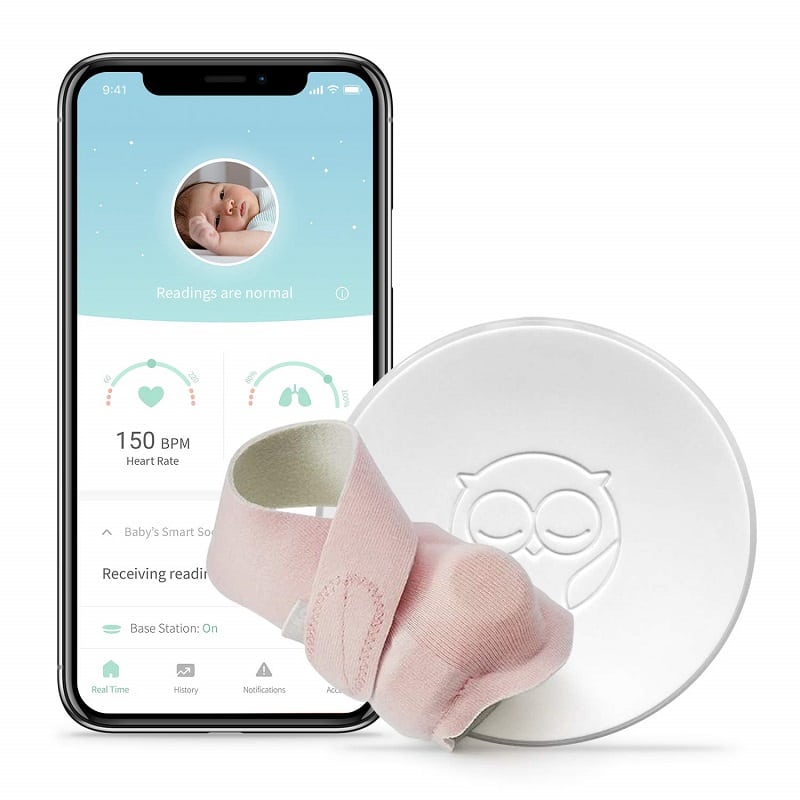
The Owlet lets you keep an eye on your baby without being with them. This unit tracks your baby’s heart rate and oxygen levels while they sleep using clinically-proven pulse oximetry. Parents are notified if something appears wrong.
The Smart Sock connects to a base station that glows green, so you know that everything is okay. It uses lights, sounds, and app notifications if your baby’s heart rate or oxygen levels are too high or too low. That helps you sleep better.
Speaking of apps, the Owlet also has a smartphone app that lets you check your baby’s real-time heart rate and oxygen levels. You can download this app on multiple phones, and it’s available on iOS and Android phones. They also added a history tab that lets you see historical trends for heart rate and oxygen levels, as well as sleep tracking. You can see how long and how well your baby sleeps each night.
The Nuby Garden is a comprehensive blender that includes everything you could need to make different recipes for your baby. Nuby included accessories to steam your baby’s food, letting you make small and large batches. It also includes accessories for you to store your baby food.
Parents can’t steam the fruits and veggies in the Nuby Garden, but the kit includes a steamer basket to put into your microwave. Then, you transfer the steamed fruits or vegetable (or both) to the blender. The kit includes two sized bowls, so you can make larger or smaller batches. It’s perfect for either making a bunch of bananas or pureeing what you have for dinner that evening.
Check Pricing and Availability
- 30 Day Full Refund Available
- Tracks Heart Rate & Oxygen Levels
- Easy App to Use
- Tracks Baby’s Sleep
- Lets You See Real-Time Vitals
- Sock Placement Alarm Might Go Off Often
- Disconnects Easily From The Base
2Snuza Hero SE – Only Monitor with Vibration
Snuza Hero SE – Only Monitor with Vibration
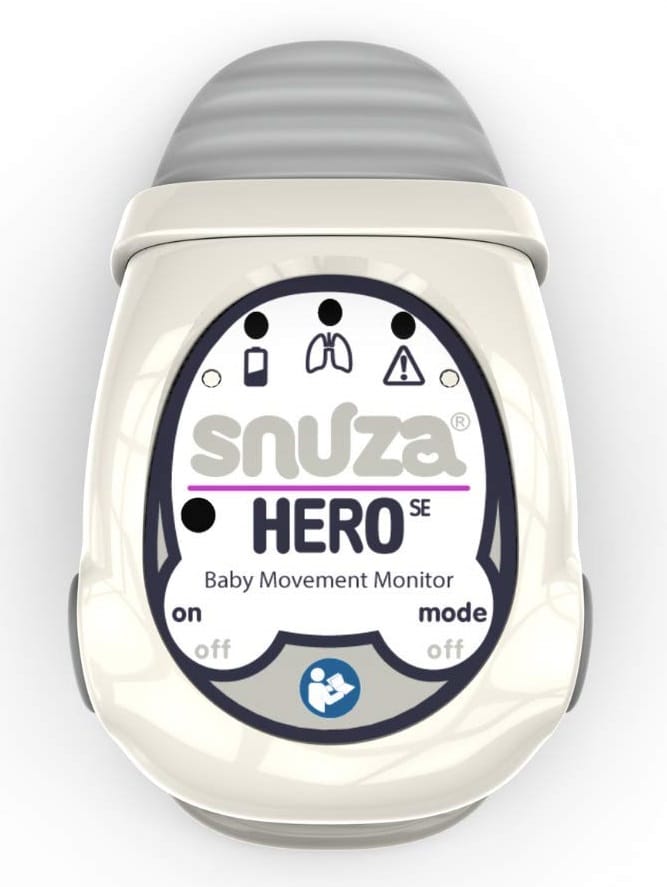
What makes the Snuza Hero unique is that it vibrates if no abdominal movements are detected for 15 seconds. Vibration is typically enough to rouse your infant, and then it reverts to monitoring mode. Snuza will perform three rousing vibrations, but if it happens a fourth time, a Rouse Warning will alert you that it has taken place three times.
This monitor is quite sensitive and picks up external movements as well, so it’s not suitable for co-sleeping. It’s also not advisable to use in a car seat or stroller as the motion can alter the results.
Check Pricing and Availability
- Alarms After 20 Seconds of No Movement
- No Wires, Pads, Cords, or External Power
- Clips on the Diaper
- Vibration Stimulus
- Might Hae False Alarms
- Batteries Die Fast
3Sense-U Breathing & Rollover Monitor – Best Clip-On Monitor
Sense-U Breathing & Rollover Monitor – Best Clip-On Monitor
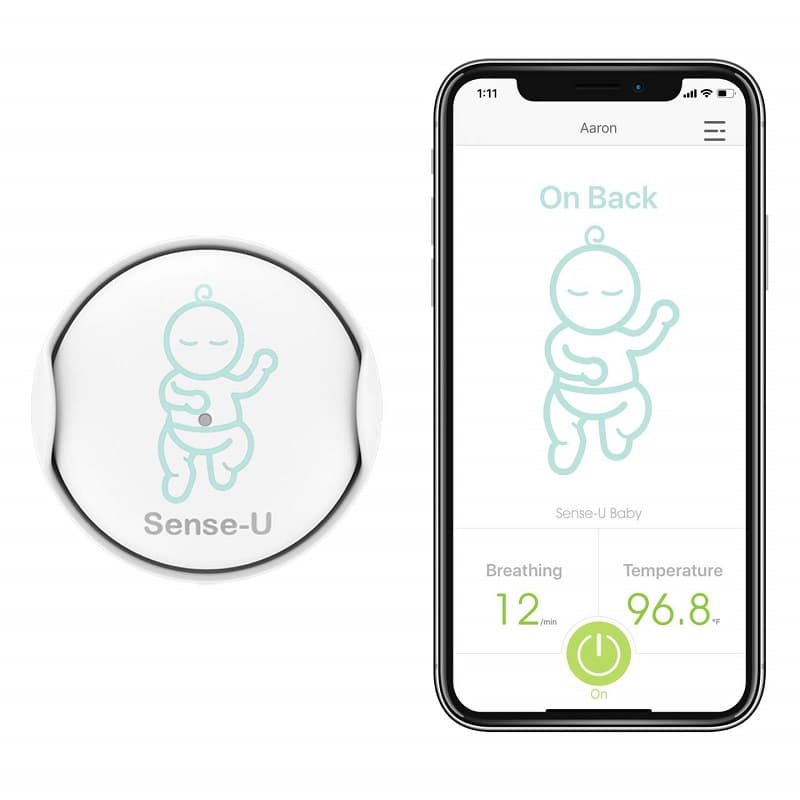
This monitor uses an upgraded, integrated, high-performance sensor chipset that accurately monitors your baby’s breathing and lets you know with an audible alarm if changes are detected. It rarely sends false alarms, and it also monitors your baby’s sleeping position. If your baby rolls over on his stomach, this monitor will send you an alert.
Sense-U also protects your baby from overheating, which is a SIDS risk, and from getting too cold. You can monitor your baby’s ambient temperature around their body with a built-in thermometer. If the temperature goes outside of preset zones, you will receive an alert.
All of the vitals can be checked in real-time using the Sense-U app. Parents can check real-time respiratory rates, sleeping position, and temperature. You can find the free app on iOS and Android.
Check Pricing and Availability
- Easy to Clip-On and Use
- Free Tracking App
- Easy to Connect on Bluetooth
- Monitors Baby Breathing, Rolling, and Room Temperature
- Can Check Real-Time Vitals
- Must Be Close to Baby – Not Suitable for Large Living Spaces
- Can Disconnect at Times
- Some Parents Report False Alarms
4Babysense 7 – Under the Mattress Baby Movement Monitor – Best for Premature Babies
Babysense 7 – Under the Mattress Baby Movement Monitor – Best for Premature Babies
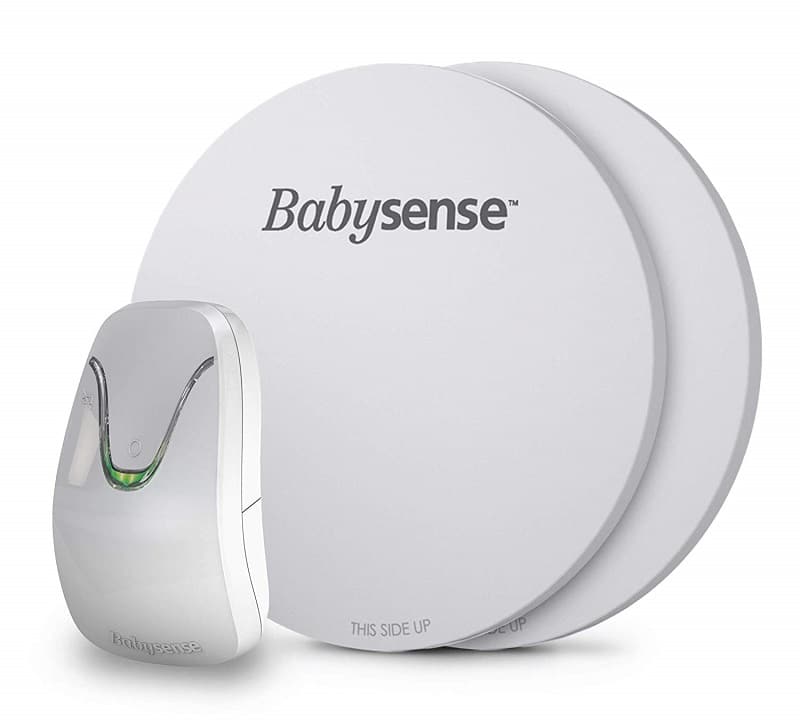
This is a non-contact monitor that comes with enhanced sensitivity and a lower risk of false alarms. Babysense sends a signal if no movement is detected within 20 seconds or if the movement rate slows to less than ten micro-movements per minute. It uses a passive sensor system that is safe and comes with two sensitive pad that provides coverage for your entire crib or bed area.
Babysense sends auditory and a red light visual alarm, and it has an easy one-button activation. The sensors are safe and emit no radiation without any harm to your baby. This monitor operates on 4 AA batteries that are not included.
Even though the AAP doesn’t recommend breathing monitors, the Babysense is listed as a medical device in Europe, Israel, Japan, Korea, Australia, and several other countries. Since this is such a trusted device, it’s an excellent choice for premature babies.
Check Pricing and Availability
- No Wires in the Crib
- Highly Sensitive
- Two, Full-Coverage Sensor Pads
- Sends Alerts Fast
- No False Alarms
- Doesn’t Have Special Functions
- Works Better With a Thin Mattress
5Cocoon Cam Plus – Best Baby Cam and Breathing Monitor Combo
Cocoon Cam Plus – Best Baby Cam and Breathing Monitor Combo
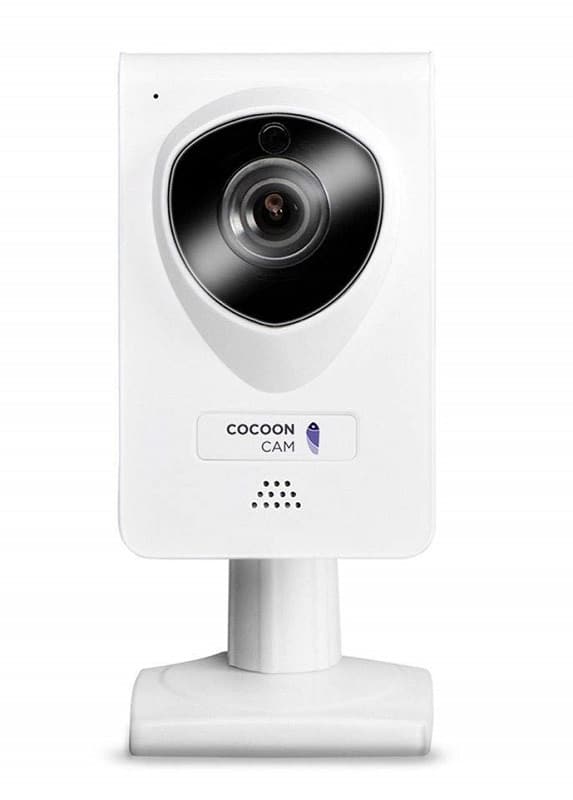
The camera has a night vision mode so that you can watch your baby’s movements whenever you want. It has a heatmap that shows where your Cocoon Cam detects movement. Best of all, you receive instant alerts if your baby’s breathing changes, he starts to cry or starts to wake up. That gives parents the ultimate peace of mind.
Cocoon Cam is an all-in-one monitor without any wearable items needed. So, you don’t need to rely on a sock that might fall off, wires, mats, or anything. The company updated the cam in 2019 by added enhanced security with HTTPS-encrypted video, audio, and vitals. No one else can see your baby aside from you.
You do need to mount this cam correctly to get the best results. This cam needs to be centered on the long side of the crib about 3 feet above the mattress. You can secure the camera to the drywall with anchors and screws.
Check Pricing and Availability
- FSA/HSA Approved
- HD Video & Night Vision
- Displays BPM
- Parents Receive Instant Alerts to Any Changes
- Easy to Install
- Must Be Mounted to the Wall
- Users Report Lag Time Between What You See and What Is Happening
6Nanny Baby Monitor – Newest on the Market
Nanny Baby Monitor – Newest on the Market
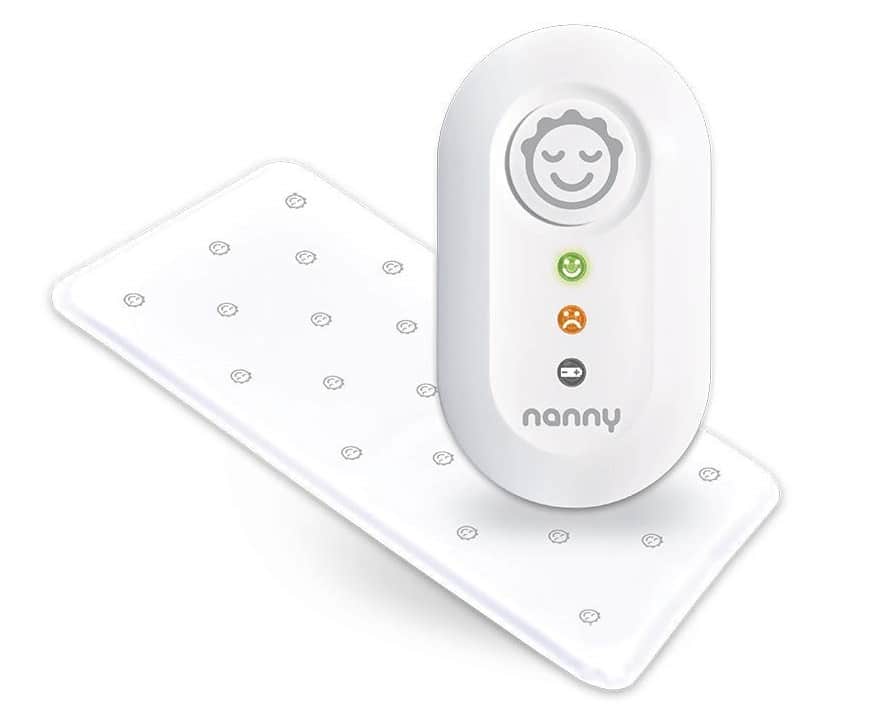
Nanny is a certified medical device by the European Union and complies with part 15 of the FCC rules and CPSIA. Something that we like about the Nanny is that it is battery operated. Just slip the pads under the mattress in the crib. You never have to worry about electrical hazards or radiation near your baby.
We might have listed this monitor higher, but since it is new in the United States, we needed to wait for more reviews and experiences to come out.
Check Pricing and Availability
- Loud Alarm
- Runs on Rechargeable Batteries
- Highly Sensitive Mat
- Certified Medical Device in the EU
- Only Monitors Breathing
- Does Have False Alarms
- Only Covers Part of the Crib
When to Seek Help for Irregular Breathing
You should always talk to your pediatrician when you have any questions or concerns about your child’s health. Any health problems in a newborn can progress rapidly, so err on the side of caution and seek help sooner rather than later.
At the same time, you’re probably wondering what the signs of breathing problems in a newborn are. Babies do weird things sometimes. They make strange, yet adorable, sounds, and you might have no clue what might cause a concern.
Here are some problematic signs.
- Frequent breathing pauses
- Your baby has a blue tinge around his lips and mouth.
- His skin has a blue tint, even with an average breathing rate.
- You notice your baby is lethargic or not responding as usual.
- Rapid breathing is a common occurrence.
These symptoms can be scary if you notice your baby experiencing them. They can be a sign of a severe issue, such as sleep apnea. Take your baby to the doctor or call 911 quickly.
Find the best natural Mosquito Repellent for babies from our top picks!
Sleep Easy for Parents
SIDS is the biggest concern for any parent, and we know that it’s a real risk even if SIDS is rare. Using one of the best baby breathing monitors gives you the peace of mind to be able to sleep well.
Always talk to your doctor if you feel as if this is the right decision for you. He might be able to let you know if it’s appropriate for your baby or not. Most importantly, remember that these monitors just ring the alarm. They won’t do anything to save your baby in the event of an emergency. So, always have a plan, including babysitters.



